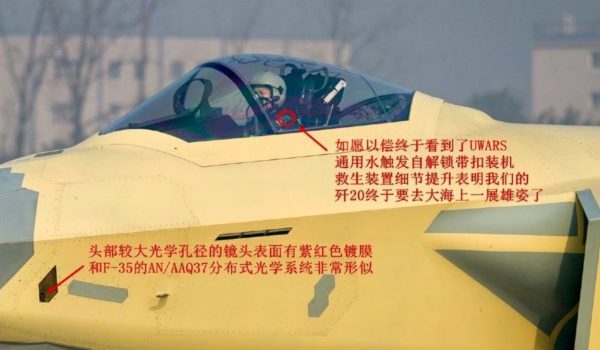
China’s internet for many years provided a wealth of information on the People’s Liberation Army, often showing off new weapons and arms technologies before they were made officially public by the secretive PLA.
Under Chinese President Xi Jinping, however, the amount and quality of disclosures on unofficial military enthusiast websites have declined sharply as China imposes tighter online controls.
Last week, one military website, the Beijing-based Chaoji Da Benying, revealed photos of China’s J-20 stealth jet fighter showing what appear to be knockoffs of two American jet fighter technologies.
An anonymous poster using the online handle “Pingtian” uploaded four photos of a new J-20 in its primer coating, a sign that it was freshly built. The photos revealed two J-20 capabilities deployed on the U.S. front-line fifth-generation stealth jet, the F-35.
The first system shown in the photographs was said to be the J-20’s high-technology distributed aperture system, or DAS.
The Northrup Grumman AN/AAQ-37 DAS for the F-35 is touted by the company as “the only 360-degree, spherical situational awareness,” an electro-optical system that provides protection all around the aircraft and warns pilots of incoming aircraft or missile threats.
Now, apparently, the Chinese have one too. “The camera lens with a relatively large optical aperture in the nose comes with a reddish-purple plating/coating,” the Chinese posting said. “It resembles very much the F-35’s AN/AAQ-37 DAS.”
A second advanced capability for the J-20 revealed by the website is the Universal Water-Activated Release System, or UWARS. The system is a battery-powered, seawater-triggered electro-explosive device used by U.S. Navy and Air Force pilots and manufactured by several American companies.
The system automatically disconnects the parachute canopy from an ejection seat pilot upon immersion in water. The system is designed to prevent pilots who ditch their planes from drowning as a result of their parachutes.
In pointing out the J-20 UWARS, the Chinese poster stated: “Getting our wish fulfilled. Finally see a plane equipped with Universal Water Activated Release System [UWARS]. The improved details show that our J-20 is finally going to reveal its majesty on the open sea.”
China has engaged in massive U.S. technology theft for the past 20 to 30 years, according to U.S. officials. It is not known if the two systems shown on the J-20 were stolen from the United States.
DAVIDSON ON INF
Arms-control proponents have been lamenting President Trump’s decision to jettison the 1987 Intermediate-Range Nuclear Forces (INF) Treaty, despite Moscow’s violation of the accord in building a new intermediate-range cruise missile banned by the pact.
The new commander of the Indo-Pacific Command, Adm. Philip Davidson, however, favors the withdrawal from the treaty and is advocating development of new U.S. INF missiles that can be deployed on land and in mobile launchers. The missiles are needed to counter the growing missile threat from China, he told a recent Capitol Hill hearing.
Under questioning from Sen. Tom Cotton, Arkansas Republican, Adm. Davidson warned about the danger from China’s intermediate-range missiles — those with ranges from 300 miles to 3,400 miles.
“China, since they are not party to the INF Treaty, has been investing in the kind of weapons that create a serious challenge to us,” the four-star admiral told the Senate Armed Services Committee last week.
“Over 95 percent of their ballistic missiles would not be permitted under the INF Treaty,” he added. “For us to have a land-based component with that kind of capability restores maneuver to the force, meaning it will make the air, the maritime and the land component much more viable in any warfare scenario and present a much greater challenge for our adversaries to threaten.”
Mr. Cotton noted that land-based missiles are less expensive and easier to operate than those deployed on ships or aircraft.
“Well, one of the things that will be required, senator, is mobility out of those assets,” Adm. Davidson said. “I think land-based assets will be that way. In this day and age, if it is fixed on the planet it is dead. You don’t even need space assets to support that. The globe has been mapped, and a ballistic missile can find its way there based on its own internal targeting. So we would have to have some mobility in those land-based assets.”
Asked if he thinks the generals of the People’s Liberation Army would be happy to confront U.S. land-based missiles with intermediate ranges, Adm. Davidson said: “No, I think it makes them unhappy.”

Leave a Reply
You must be logged in to post a comment.